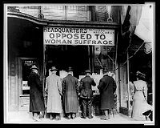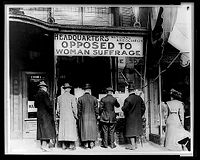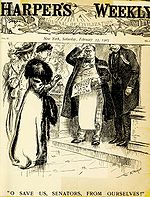
Anti-suffragism
Encyclopedia


Women's suffrage
Women's suffrage or woman suffrage is the right of women to vote and to run for office. The expression is also used for the economic and political reform movement aimed at extending these rights to women and without any restrictions or qualifications such as property ownership, payment of tax, or...
in the United States
United States
The United States of America is a federal constitutional republic comprising fifty states and a federal district...
and United Kingdom
United Kingdom of Great Britain and Ireland
The United Kingdom of Great Britain and Ireland was the formal name of the United Kingdom during the period when what is now the Republic of Ireland formed a part of it....
. It was closely associated with "domestic feminism", the belief that women had the right to complete freedom within the home.
The Women's National Anti-Suffrage League
Women's National Anti-Suffrage League
The Women's National Anti-Suffrage League was established in London on 21 July 1908. Its aims were to oppose women being granted the vote in United Kingdom parliamentary elections, although it did support their having votes in local government elections...
, publisher of the Anti-Suffrage Review, submitted a petition to Parliament in 1907 with 87,500 names, but it was rejected by the Petitions Committee of Parliament as "informal".
In New York
New York
New York is a state in the Northeastern region of the United States. It is the nation's third most populous state. New York is bordered by New Jersey and Pennsylvania to the south, and by Connecticut, Massachusetts and Vermont to the east...
, the New York State Association Opposed to Woman Suffrage was founded in 1897, and by 1908 it had over 90 members. It was active in producing pamphlets and publications explaining their views of women's suffrage, until the Nineteenth Amendment to the United States Constitution
Nineteenth Amendment to the United States Constitution
The Nineteenth Amendment to the United States Constitution prohibits any United States citizen to be denied the right to vote based on sex. It was ratified on August 18, 1920....
was passed in 1920. A Geneva
Geneva, New York
Geneva is a city in Ontario and Seneca counties in the U.S. state of New York. The population was 13,617 at the 2000 census. Some claim it is named after the city and canton of Geneva in Switzerland. Others believe the name came from confusion over the letters in the word "Seneca" written in cursive...
branch was founded in 1909. The suffragists in New York often extended invitations to open discussion with the anti-suffragists.
The New York association had its own magazine, first The Anti-Suffragist published by Mrs. William Winslow Crannell from July 1908 to April 1912, later The Woman's Protest produced by the organization at large.
After the passage of the Nineteenth Amendment to the United States Constitution, a coalition of anti-suffragists organized themselves into a political anti-feminist movement in order to "oppose expansion of social welfare programs, women's peace efforts, and to foster a political culture hostile to progressive female activists. They effectively blended anti-feminism and anti-radicalism by embracing and utilizing the hysteria of the post-World War I Red Scare."
Anti-suffragism was not limited to conservative elements. The anarchist Emma Goldman
Emma Goldman
Emma Goldman was an anarchist known for her political activism, writing and speeches. She played a pivotal role in the development of anarchist political philosophy in North America and Europe in the first half of the twentieth century....
opposed suffragism on the grounds that women were more inclined toward legal enforcement of morality (as in the Women's Temperance Leagues); that women were the equals of men; and that suffrage would not make a difference. She also said that activists ought to advocate revolution
Revolution
A revolution is a fundamental change in power or organizational structures that takes place in a relatively short period of time.Aristotle described two types of political revolution:...
rather than seek greater privileges within an inherently unjust system. Progressives criticized suffrage in the Utah Territory
Utah Territory
The Territory of Utah was an organized incorporated territory of the United States that existed from September 9, 1850, until January 4, 1896, when the final extent of the territory was admitted to the Union as the State of Utah....
as a cynical Mormon
Mormon
The term Mormon most commonly denotes an adherent, practitioner, follower, or constituent of Mormonism, which is the largest branch of the Latter Day Saint movement in restorationist Christianity...
ploy, resulting in the passage of the Edmunds-Tucker Act
Edmunds-Tucker Act
The Edmunds–Tucker Act of 1887 was passed in response to the dispute between the United States Congress and The Church of Jesus Christ of Latter-day Saints regarding polygamy. The act is found in US Code Title 48 & 1461, full text as 24 Stat. 635, with this annotation to be interpreted as Volume...
.
Further reading
- Jablonsky, Thomas J, "The Home, Heaven, and Mother Party: Female Anti-Suffragists in the United States, 1868-1920." Brooklyn: Carlson, 1994
- Camhi, Jane Jerome. Women Against Women: American Anti-Suffragism, 1880-1920. Brooklyn, N.Y.: Carlson Pub., 1994. ISBN 0-926019-65-1
- Almroth WrightAlmroth WrightSir Almroth Edward Wright, KBE, CB was a British bacteriologist and immunologist.He is notable for developing a system of anti-typhoid fever inoculation, recognizing early on that antibiotics would create resistant bacteria and being a strong advocate for preventive medicine.-Biography:Wright was...
. The Unexpurgated Case Against Woman Suffrage. London: Constable & Co. Ltd, 1913. Available online: - Harrison, Brian Howard. Separate Spheres : The Opposition to Women’s Suffrage in Britain. London : Croom Helm, 1978.
- Nielsen, Kim. How Did Women Antifeminists Shape and Limit the Social Reform Movements of the 1920s?. Binghamton, NY: State University of New York, 2004 (electronic resource).

